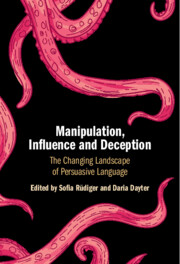
-
Select format
-
- Publisher:
- Cambridge University Press
- Publication date:
- 10 June 2025
- 24 April 2025
- ISBN:
- 9781009105194
- 9781009098724
- Dimensions:
- (229 x 152 mm)
- Weight & Pages:
- 0.63kg, 330 Pages
- Dimensions:
- Weight & Pages:
You may already have access via personal or institutional login
Book description
In an era characterised by information saturation and the rapid evolution of digital communication platforms, the study of persuasive language is undergoing profound developments. Bringing together cutting-edge research from a team of internationally acclaimed experts, this timely book examines the transformations occurring in the domain of persuasive language in contemporary society. It dissects the intricate web of manipulation, influence and deception, providing in-depth analyses of the potent mechanisms governing communication. Each chapter offers empirical insights from a range of different scholarly perspectives, including corpus linguistics, conversation analysis, forensic linguistics, pragmatics, discourse analysis, phonetics and human-robot interactions. It opens with a comprehensive introductory chapter, making the research accessible to readers without extensive background knowledge. Equipping readers with the tools to critically engage with the multifaceted dynamics of language and persuasion, this is an indispensable resource for anyone striving to fathom the evolving realm of persuasive language.
Contents
Metrics
Altmetric attention score
Full text views
Full text views help Loading metrics...
Loading metrics...
* Views captured on Cambridge Core between #date#. This data will be updated every 24 hours.
Usage data cannot currently be displayed.
Accessibility standard: Missing or limited accessibility features
Why this information is here
This section outlines the accessibility features of this content - including support for screen readers, full keyboard navigation and high-contrast display options. This may not be relevant for you.
Accessibility Information
The PDF of this book is known to have missing or limited accessibility features. We may be reviewing its accessibility for future improvement, but final compliance is not yet assured and may be subject to legal exceptions. If you have any questions, please contact accessibility@cambridge.org.
Content Navigation
Table of contents navigation
Allows you to navigate directly to chapters, sections, or non‐text items through a linked table of contents, reducing the need for extensive scrolling.
Index navigation
Provides an interactive index, letting you go straight to where a term or subject appears in the text without manual searching.
Reading Order and Textual Equivalents
Single logical reading order
You will encounter all content (including footnotes, captions, etc.) in a clear, sequential flow, making it easier to follow with assistive tools like screen readers.
Visual Accessibility
Use of colour is not sole means of conveying information
You will still understand key ideas or prompts without relying solely on colour, which is especially helpful if you have colour vision deficiencies.
Use of high contrast between text and background colour
You benefit from high‐contrast text, which improves legibility if you have low vision or if you are reading in less‐than‐ideal lighting conditions.

